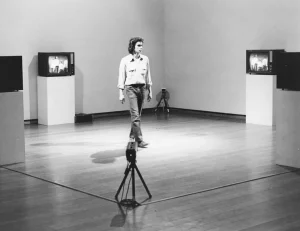Peter Campus
Video art, performance
United States

Peter Campus
American artist Peter Campus (born 1937 in New York)
is one of the most important artists
precursors of video. However, the nature of its
works, with particularly delicate settings, has limited
their presentation. Since the
closed circuit installations and videos produced since 1971
up to the most recent works, all explore the
process of perception and vision based on
on the particular characteristics of the electronic image
then digital.
“Interactive” devices.
The viewer must enter a field of experience, come
play there, risk something of one’s own image,
without which nothing happens, the work does not take place. Grace
live, the “interactive” devices of the 1970s
constitute so many enigmas where the doubles of oneself
never coincide, where the relationship to its image is
always problematic.
Digital and lighter.
From 1978, Peter Campus decided to leave
his studio to devote himself solely to
photography. Nature will now be his workshop.
When he returned to video in 1996, it was
become digital and lighter. Achievements
then acquire an intimate and poetic character, but
equally experimental. In 2007, he chose to make
“videographies” – still shots without editing – of his
familiar landscapes of Long Island. He will then work
for several years with digital material
of his images. The degree of abstraction that it gives them
confers by processing moving pixels engages the
spectator in a new exercise of perception and
of interpretation.
Ultra-high definition.
His intense relationship with the chosen place, his attention to
light, color, frame, are best expressed in
his most recent work shot in ultra-high definition
(4K), which unfolds in a space
environmental. The spectator’s gaze interacts
with the sensitivity and emotion of another, the artist.
Video has never left him, says Peter Campus, it’s his
medium. video ergo sum.
Kiva (1971)
Kiva (1971) is a complex vision machine. Two mirrors suspended by wires, like mobiles, reflect
to the camera both its own image and an image “panoramic” of the environment and visitors,
fragmented, multiplied and constantly changing. Sensitive to ambient air movements, they allow
by their uncertain rotation to integrate the random into a carefully calculated technical package. Without a doubt
Is Kiva a critical commentary on surveillance, since the arrangement of the elements ironically makes any control impossible. But the piece aims first to involve the viewer in a specific relationship to space and its image which is here of total disorientation.
Three Transitions (excerpt). 1973
In Three Transitions, Campus presents three introspective self-portraits that incorporate his dry humor. He begins with an image created by two cameras facing opposite sides of a paper wall and filming simultaneously. His back to one camera, Campus cuts through the paper. In the double image, it appears as if he is cutting through his back, which is both disconcerting and tongue-in-cheek. Campus then uses the “chroma–key effect” of superimposing one video image onto a similarly colored area of another image. He applies blue paint to his face, and during this process another image of himself is revealed; he then superimposes his image on a piece of blue paper, which he sets afire. As Three Transitions moves between deadpan humor and seeming self-destruction, Campus explores the limits of visual perception as a measure of reality.
Television.
Faces and masks have long been subjects in art, but, with the advent of television, these analytical discursive figures intimately entered our daily lives. Campus’s video art is concerned with exploring the subtle balance between remote but penetrating and formal, but unsettling, elements.
Interface (1972)
Interface (1972) confronts the visitor with his reflection in a window and his video image, inverted in relation to it – two images of himself as others see him. Although they are both “live” and of the same dimension thanks to the projection, these doubles of different natures can never coincide. In addition to their inversion, the color reflection seems to float forward, while the projected video image, slightly milky, passes through the glass to reach the wall. Given the orientation of the camera and that of the video projector, the doubles move apart or get closer depending on the movement of the visitor in front of the glass, resisting any assimilation, allowing at best a monstrous figure of oneself.
Optical Sockets (1972-1973)
Optical Sockets (1972-1973) invites the viewer to enter a field of experience defined by four cameras and four monitors. He is then trapped by four external points of view on himself, which are superimposed in the same image. While standing in the central area. He will produce a strange two-dimensional cubist body, his own, composed by the addition of several simultaneous faces of himself. Depending on his position in the field, the scale and place of his body(ies) in the image vary, leading him to experience relativity. Man at the center of the universe is never anything other than a composite of points of view in perpetual transformation.